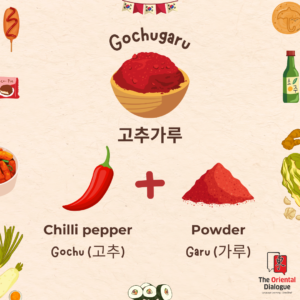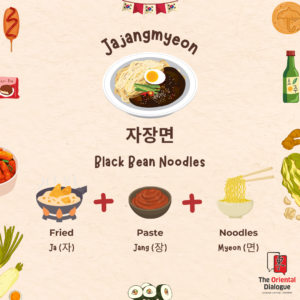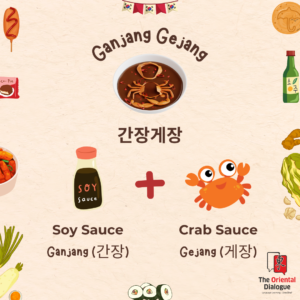Korean cuisine has been steadily gaining popularity around the globe, captivating taste buds with its delightful flavors and healthy ingredients. However, beyond just the taste, have you ever wondered about the stories behind the names of your favorite Korean dishes? Let’s delve into the fascinating world of Korean food etymology and uncover the meanings behind some common dishes.
 Gochugaru (고추가루) – Chili Pepper Powder: At the heart of many Korean dishes lies gochugaru, or chili pepper powder. The word gochu translates to “chili pepper,” while garu means “powder.” It’s no wonder that this spice, with its vibrant color and spicy kick, plays such a central role in Korean cuisine.
Gochugaru (고추가루) – Chili Pepper Powder: At the heart of many Korean dishes lies gochugaru, or chili pepper powder. The word gochu translates to “chili pepper,” while garu means “powder.” It’s no wonder that this spice, with its vibrant color and spicy kick, plays such a central role in Korean cuisine.
Gochujang (고추장) – Chili Pepper Paste: Another staple in Korean cooking is gochujang, a savory and spicy fermented chili pepper paste. Here, gochu once again refers to “chili pepper,” while jang means “paste.” This versatile condiment adds depth and complexity to a wide range of dishes, from stews to marinades.
Ssamjang (쌈장) – Wrap Paste: Ssamjang is a flavorful dipping sauce commonly served with Korean barbecue. The word ssam translates to “wrap,” indicating its intended use with lettuce wraps, while jang once again denotes “paste.” This blend of soybean paste, chili paste, and other ingredients enhances the taste of grilled meats and vegetables.
Jajangmyeon (짜장면) – Fried Paste Noodles: Jajangmyeon is a popular Korean-Chinese noodle dish featuring a savory black bean sauce. The term ja means “fried,” jang signifies “paste,” and myeon refers to “noodles.” This comforting dish is beloved for its rich flavor and satisfying texture.
Bulgogi (불고기) – Fire Meat: Bulgogi, often dubbed as “fire meat,” is a classic Korean barbecue dish known for its tender, marinated beef. Bul means “fire,” while gogi translates to “meat.” This dish exemplifies the balance of sweet and savory flavors that Korean cuisine is celebrated for.
Dwaejigogi (돼지고기) – Pig Meat: Dwaejigogi refers to pork in Korean cuisine. Dwaeji means “pig,” while gogi once again signifies “meat.” From spicy pork bulgogi to hearty stews, pork plays a significant role in Korean culinary traditions.
Kimbap (김밥) – Seaweed Rice Roll: Kimbap, often likened to Korean sushi, features seasoned rice and various fillings rolled in seaweed. Kim denotes “seaweed,” while bap means “rice.” This portable and nutritious snack is perfect for a quick meal on the go.
Bibimbap (비빔밥) – Mixed Rice: Bibimbap is a colorful and nutritious dish consisting of mixed vegetables, meat, and a fried egg served over rice. Bibim translates to “mixed,” while bap once again means “rice.” This dish showcases the beauty of combining various flavors and textures in one bowl.
Tteokbokki (떡볶이) – Rice Cake Stir-fry: Tteokbokki features chewy rice cakes stir-fried in a spicy and sweet sauce. Tteok refers to “rice cake,” while bokki signifies “stir-fried.” This popular street food dish is beloved for its addictive combination of flavors and textures.
Samgyeopsal (삼겹살) – Three Layer Meat: Samgyeopsal consists of thick slices of pork belly grilled to perfection. Sam means “three,” gyeop denotes “layer,” and sal translates to “meat/flesh.” This DIY barbecue experience is a favorite among Koreans and visitors alike.
Bungeo-ppang (붕어빵) – Carp Bread: Bungeo-ppang is a fish-shaped pastry filled with sweet red bean paste. Bungeo refers to “carp,” while ppang means “bread.” Despite its name, this delightful treat contains no fish but is instead named for its shape.
Rabokki (라볶이) – Ramyeon + Tteokbokki: Rabokki is a fusion dish combining spicy tteokbokki with instant ramyeon noodles. This mashup of flavors and textures is a popular street food snack in Korea, offering a satisfyingly spicy kick.
Chimaek (치맥) – Chicken + Beer: Chimaek is a beloved pairing of fried chicken (chikin) and beer (maekju). This dynamic duo has become a cultural phenomenon in Korea, with dedicated establishments serving up crispy chicken alongside cold brews.
Naengmyeon (냉면) – Cold Noodles: Naengmyeon combines naeng (cold) and myeon (noodles), offering a refreshing dish perfect for hot summer days.
Janchigugsu (잔치국수) – Banquet Noodles: Janchigugsu features janchi (banquet) and gugsu (noodles), symbolizing celebration and community.
Kalgugsu (칼국수) – Knife Noodles: Kalgugsu combines kal (knife) and gugsu (noodles), reflecting the hand-cut noodles traditionally used in this dish.
Bibim Guksu (비빔국수) – Mixed Noodles: Bibim Guksu features bibim (mixing) and gugsu (noodles), offering a flavorful blend of vegetables and seasonings.
 Kongguksu (콩국수) – Soybean Noodles: Kongguksu combines kong (soybean) and gugsu (noodles), featuring a creamy soybean broth.
Kongguksu (콩국수) – Soybean Noodles: Kongguksu combines kong (soybean) and gugsu (noodles), featuring a creamy soybean broth.
Kimchijjigae (김치찌개) – Kimchi Stew: Kimchijjigae features kimchi (fermented vegetables) and jjigae (stew), showcasing the spicy and tangy flavors of kimchi.
Sundubujjigae (순두부찌개) – Soft Tofu Stew: Sundubujjigae features sundubu (soft tofu) and jjigae (stew), offering a comforting and nutritious meal.
Ganjang Gejang (간장게장) – Soy Sauce Crab: Ganjang Gejang combines ganjang (soy sauce) and gejang (crab), highlighting the umami-rich flavors of soy sauce-marinated crab.
Exploring the meanings behind common Korean food names adds a new dimension to the dining experience, offering insights into the ingredients, preparation methods, and cultural significance of these dishes. Whether you’re savoring the fiery heat of gochujang or indulging in the comforting flavors of bibimbap, each bite tells a story steeped in tradition and flavor. So, the next time you enjoy Korean cuisine, remember the rich heritage behind each dish’s name. Happy eating!
“Ready to Dive Deeper into Korean Language and Culture?”
At The Oriental Dialogue, we’re passionate about helping learners like you expand their horizons through language education. Our language learning courses are designed to not only enhance your proficiency in Korean but also deepen your understanding of its rich culture.
Explore our comprehensive range of courses in Korean, Chinese, and Japanese on The Oriental Dialogue’s website. Register for our free online monthly demo session to experience firsthand how our courses are structured and delivered.
Attend all three demo sessions—Korean, Chinese, and Japanese—to discover which language resonates with you the most and aligns best with your language learning journey. Let us ignite your passion for learning and guide you toward fluency in Korean and beyond.





